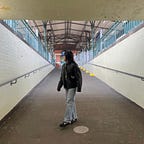Hosier Lane: Where vandalism and street art negotiate
When we talk about street art in Melbourne, we talk about the celebrated Hosier Lane. It is the one place where artists and ordinary people who rejoice in art — mainly graffiti — go to because not only it is free and accessible, but it also has high visibility as it is situated near Flinders Street station and very unlikely for street artists to be prosecuted. However, how is it free of cost? Whose space is this and what rights do the people have in it?
Street art has been the heart of Melbourne’s cultural identity for many years. It has become integral to Hosier Lane, which is now considered a tourist spot in the central business district, well-known for its art filled-laneway. The street art on Hosier Lane are passively allowed without permit and not removed; that is probably the sole reason why street artists everywhere in Melbourne are ecstatic. Yet, when a group of them carried canisters in the size of fire extinguishers painted the walls in 2018, the term “street art” is replaced by “vandalism.” Clearly, there is a blurred line between the definitions of “street art” and “vandalism”; both are often created on public properties and communicate social commentaries, with some argue that they should be protected, while others recommend a regulation.
Culture Kings (oh, the irony!), a streetwear capital whose one of the stores is located on Hosier Lane, made a complaint to the police about the painting on their back entrance which has overpainted the promotional art that they paid an artist to do. City of Melbourne then responded that street art is only legal where the property owner has provided a written permission. This shows that Hosier Lane is, at heart, at the cusp of the relationship between street art, property owners, and the government. ‘Looking at street art and graffiti keeps raising a wide variety of real issues; issues like private and public property, freedom of speech…’ (Holsworth, 2016). The circumstance has placed Hosier Lane to be in a grey area in regards to the accessibility and rules for street artists to create art there. It showed that property owners and government’s appreciation of street art only stretches to an extent that it increases tourism and bring customers into stores, but when these street artists rattle them, they will not hesitate to call the police.
This brings up a discussion about how we should perceive street art as a media of expression. Should we see them as sympathies toward the system and government that might spike disorderly in an environment? Or rather, see them as accessible art that put cultural flairs in public spaces? When street artists paint their art over another art which advertised a store — a corporate greed seeking immediate profit; the complete opposite of the values Hosier Lane hold—would it be right then, to criminalize them? Is it the correct move for a big corporate (or property owner) to not only piggy back on the street art culture and exploit them, but also act negligent towards the very same culture they have claimed to be?
